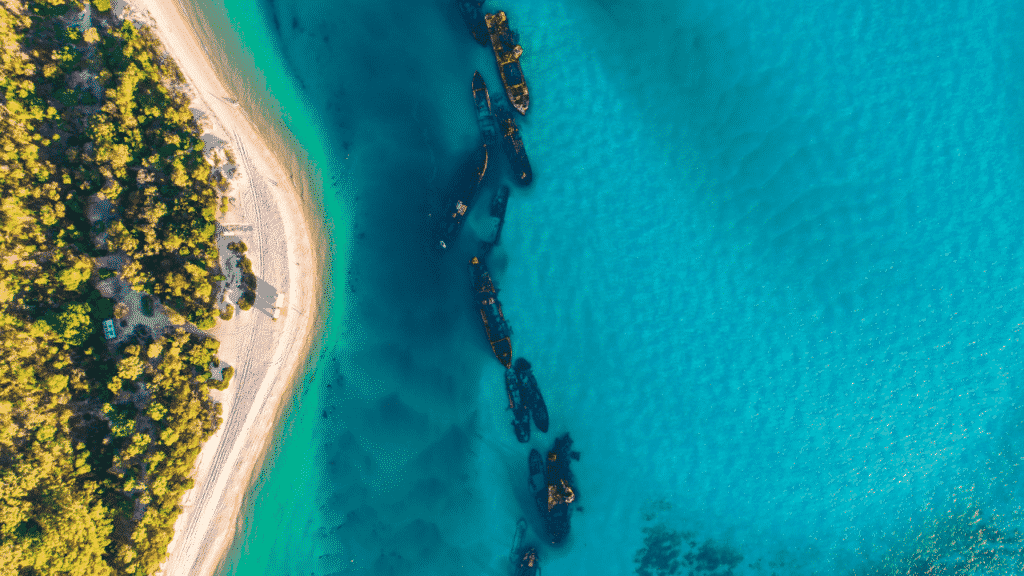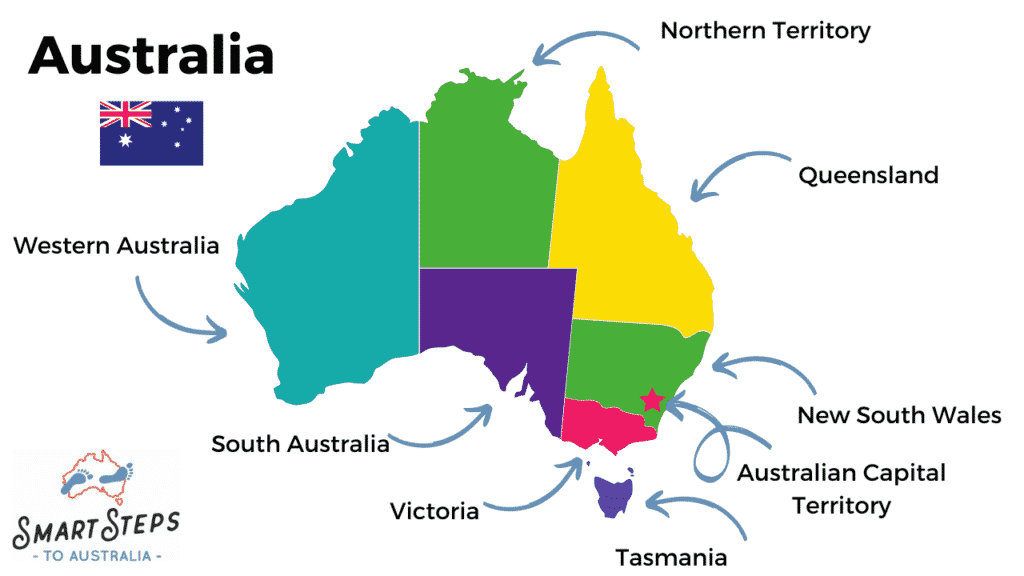
I acknowledge the Traditional Owners of Country throughout Australia and recognise their continuing connection to land, waters and culture. I pay my respects to their Elders past, present and emerging. I live on the land of the Gubbi Gubbi people and thank them for the privilege of being able to live in such an incredible part of the world.
Australia is a vast country with a rich, ancient heritage, incredible wildlife and the clearest oceans. It’s a place where you can find turquoise lagoons, dazzling-white sand, vibrant ochre landscapes, bustling shopping districts, insanely amazing coffee and a deep blue sky that seems to roll on and on and on. There are endless wonders to explore here.
For me, Australia is somewhere to enjoy life-changing adventures and create awesome memories. Australia is a country that makes me happy – that big blue, cloudless sky and never-ending sunshine fill my cup every day and I’m so happy that I’m now an Australian citizen and I’m able to call this country home.
This page about planning a trip to Australia contains affiliate links
This is Australia!
In this Australia guide, I’m sharing an overview about Australia – think of it a bit like an Australia orientation guide where you find out the basics about places, etiquette, customs, currency, timezones and all the things. I’ll be answering the basics like how many states and territories does Australia have and which are the largest cities in Australia through to sharing the best attractions in Australia and highlighting famous places in Australia (so be sure to keep checking back as I add more facts and information about Australia!)
This is a brand new section of the blog and I’ll be creating lots of new posts to link off to so you can go deeper into these subjects and immerse yourself into the way of life in Australia. This section will become a full travel guide to Australia to help you plan your Australian migration or your trip of a lifetime to Australia.
Whether you’re considering different states in Australia to live, or you’re looking for the best places to go in Australia on holiday, this page of information about Australia has you covered.
I’ve lived in Australia for seven years now and, prior to that, I travelled extensively around Australia as a backpacker. I’m also a seasoned Australia travel writer having been a writer for Australia and New Zealand magazine for over 13 years. My aim for this Australia guide to help you discover places to visit in Australia and help you make decisions about where you might want to live or visit while also giving you all of the information you need about the practicalities of life in Australia.
Get started planning a trip to Australia or doing research for your big move!
Table of Contents

Map of Australia
First up, here’s an overview of the territories and states in Australia.
Are you wondering how many states are there in Australia? Or how many Australian territories? The map below shows you the six states of Australia (Western Australia, Queensland, New South Wales, Tasmania, Victoria and South Australia) and the two Australian territories (Northern Territory and Australian Capital Territory).
States and territories of Australia map

Further reading:
Australia facts and information
Let’s get started with some of the basic facts, figures and information about Australia.
Welcome to Country and Acknowledgement of Country
At the top of this page, I included my Acknowledgement of Country which I feel is an important way of showing my respect to the traditional custodians of these lands past and present (only traditional owners of the land/custodians can deliver a Welcome to Country greeting). Meetings and events often begin with one of these greetings. You can learn more about Welcome to Country and Acknowledgement of Country greetings here. There is a lot of work still to do to reconcile Australia and I urge you to learn about Indigenous cultures in Australia, to learn about the wrongs of the past and be part of a positive future. I know I still have a lot to learn and a long way to go, but it’s important to me as an Australian citizen to be educated and encourage you to learn more too. You can learn more at Reconciliation Australia.
Australia Day
Australia Day takes place on 26 January annually. It commemorates the date that Captain Arthur Phillip landed at Sydney Cove, raised the Union Jack and proclaimed British sovereignty over part of the continent in 1788. Australia Day is a significant public holiday in Australia, however, it is a date filled with controversy. You can learn more about Australia Day and why the date is controversial here.
Australia size
Australia is the sixth-largest country in the world by total area. Mainland Australia is the world’s largest island, and Australia is also the world’s smallest continent.
Australia has a population of almost 26 million people and a land area of 7.692 million square km. To put its size into perspective, it’s a similar size to the USA, and about 50% larger than Europe. Do not underestimate size and distance when working on your Australia route planning for an Australian road trip – you need to allow plenty of time for driving distances and for flights across the country!
Australia’s capitals
Australia’s capital city is Canberra in the Australian Capital Territory.
All of the other states and territories in Australia each have their own capital city.
These are:
Perth (Western Australia),
Brisbane (Queensland),
Darwin (Northern Territory),
Melbourne (Victoria),
Sydney (New South Wales),
Adelaide (South Australia)
and
Hobart (Tasmania).
Australian time zones
Australia is divided into three different time zones which means when you’re travelling in Australia, it’s easy to cross over an Australian time zone line without even noticing! (That happened to us when driving in a motorhome from New South Wales into Queensland so I speak from experience as we were totally caught out by it!)
The three time zones in Australia are: Australian Eastern Standard Time (AEST), Australian Central Standard Time (ACST), and Australian Western Standard Time (AWST). However, some locations observe daylight saving time and others don’t, so be sure to double-check that. For instance, although Queensland is one of the states that follows AEST, we don’t observe daylight savings here so for half of the year we are an hour different to the rest of the states and territories that follow AEST. That also means when calling the UK or another country that changes their clocks every six months, the time difference changes by an hour depending on the time of year (so the UK is either nine hours behind Queensland or ten hours).
The time zone difference is something to get used to in Australia, especially if you have online phone calls or meetings with people in other states or territories for your work. You always need to remember to ask where people are located to make sure you’re timings match!
Australia’s climate
Australia’s seasons are the opposite of those in the northern hemisphere. This means spring is September – November; Summer is December – February; Autumn is March – May; and winter is June – August.
Australia has a wide range of weather and we even get snow in some parts! You can find out more about the weather in Australia here.
Further reading about weather in Australia:
Does it snow in Australia?
5 Things I love about autumn in Australia
When is winter in Australia? Get these winter tips abotu what to wear and staying warm!
Check out this guide to spring in Australia
Learn all about summer in Australia
Australia money
The currency in Australia is the Australian dollar $. It comes in notes: $5, $10, $20, $50, $100 and coins: 5c, 10c, 20c, 50c, $1, $2. If something costs $1.99 and you pay in cash, the amount is rounded as there are no 1c coins.
There are four big banks in Australia: Commonwealth Bank of Australia (CBA) – you can find out about opening an account with them here; Westpac Banking Corporation; Australia and New Zealand Banking Group (ANZ); and National Australia Bank (NAB).
Money in Australia is withdrawn from ATMs (they aren’t called cashpoints or cash machines as we call them in the UK!).
Electronic payment points in shops are generally called EFTPOS machines (this is the brand of a private payment system although like hoover is now used to describe any vacuum cleaner, most people use EFTPOS to mean the payment machine regardless of brand).
When you pay with a debit card you can usually tap or wave your card at the machine to make a payment.
When you pay with a card, you are usually asked if you want to pay by ‘cheque, savings or credit?’ and you have to select one option on the payment machine. When we arrived, our bank told us to always select ‘savings’ when paying with our debit card as this draws the funds from your current account. If paying with a credit card you should select ‘credit’. You can also select ‘credit’ when paying with your debit card too, but be aware you may be charged a surcharge for this. I’ve also heard that if your debit card is attached to both a current account and savings, selecting ‘savings’ will mean it comes from your savings account rather than your current account so in this instance choosing ‘cheque’ is the right option! If in doubt about which to choose, ask your bank.
You can move money into an Australian bank account by using a money transfer service. I partner with OFX.
Australia phones
The access code to dial Australia from another country is +61.
The phone number for emergencies in Australia is 000.
Getting around Australia
Because of the huge scale, Australia doesn’t have a fully comprehensive rail network like the UK has although each city has it’s own public transport systems and these might also include trams and ferries as well as trains and buses. It’s also common here to hop on a flight to a different city as it’s a quick and efficient way to travel.
The main airlines that run domestic flights within Australia are: Qantas, Virgin, Jetstar, Rex Air and Alliance.
The main bus service for long distance travel is Greyhound and you can buy tickets or passes that allow you to hop on or off.
For holidays to Australia, you can hire cars (I love DriveAway for this) or motorhomes (shop for quotes at MotorhomeRepublic) – Australia is much easier to explore when you have your own transport!
This page is being updated with more information to come about the different territories and states in Australia, places to visit and more….Keep checking back for more!
